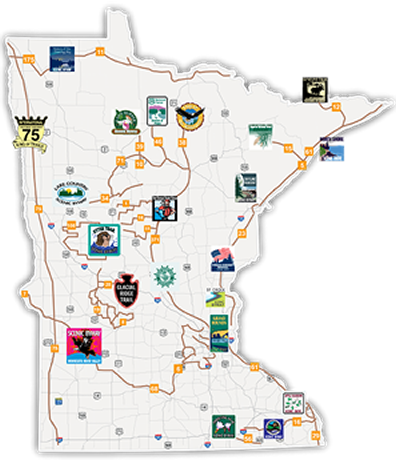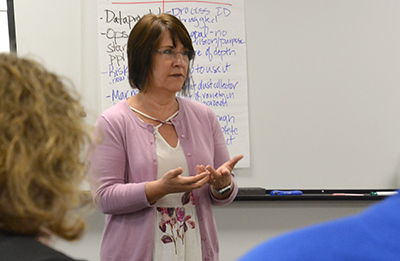 |
|

|
 |
TABLE of CONTENTS
|
Two Hwy 169 projects in Champlin require close coordination between MnDOT, partners |
By Kent Barnard, Metro District public affairs

Construction crews from Ames Construction made quick work demolishing the southbound Hwy 169 Elm Creek bridge in Champlin. Work began on the southbound bridge and roadway in spring 2018. Photo by Juan Podesta, Golden Valley Resident Office
|
After an annual bridge inspection in early 2015, Metro District inspectors found extensive deterioration under both northbound and southbound Hwy 169 bridges over Elm Creek (the Mill Pond) in Champlin, a city located in the northwestern Twin Cities Metro area. The findings led the district to place weight limits on both bridges for nearly eight months and to make emergency repairs to shore up the bridge decks. Once restrictions were removed, the shoulders of the bridge remained closed and both government agencies began fast-paced planning for the bridges’ replacement.
Fast forward to today. That project to replace the two bridges, realign the highway just south and of the Mississippi River and make other improvements on Hwy 169 between East Hayden Lake Road and the river is well underway, having begun in fall 2017, with expected completion in September 2018.
However, future pavement repairs on the highway between Hayden Lake Road (just south of the bridges) to Hwy 610 in Brooklyn Park meant that residents, businesses and commuters would face the inconvenience of bridge and highway construction in 2017 and 2018, only to be hit with construction and traffic restrictions to the south just a few years later.
Metro District staff scrambled to develop plans for the repairs and resurfacing, and advocated for funding to carry out the additional repairs, resurfacing and safety improvements on Hwy 169 between East Hayden Lake Road and Hwy 610. Once that funding was secured, both projects moved forward starting in October 2017.
And once the project was scheduled, public outreach efforts kicked into high gear with several public open houses, business meetings and many visits to schools, local governments and businesses that would be affected by the increased traffic congestion and delays created by the projects.
“Working on both projects simultaneously allowed us to lessen the length of time residents, businesses and commuters are inconvenienced,” said Chris Hoberg, Metro District West Area engineer.
Both projects underway simultaneously using two separate contractors has required a high level of coordination between the projects. By synchronizing the sides of the highway under construction and coordinating related lane restrictions and road closures, progress on the two projects has been steady.
Replacing the Elm Creek bridges, realigning the highway and access roads and a new pavement surface will improve safety and reduce congestion while extending the life of the highway, bridges and drainage system in Champlin. Additional amenities built by the city include a new pedestrian-bicycle crossing beneath the highway at West River Road south of the Elm Creek bridges as well as new signal systems and closure of some access along the highway. Safety also will be improved with upgraded signals and pedestrian crossings that now meet the Americans with Disability Act standards at ramps along Hwy 169.
The southbound bridge and southbound roadway have been completed and work on the northbound roadway and bridge is nearing completion. For more information about the Hwy 169 projects, visit the www.mndot.gov/metro/projects/hwy169champlin.
|
 |
|

|
 |
TABLE of CONTENTS
 |
Lake Mille Lacs is designated state's latest Scenic Byway |
By Sue Roe

This map shows the scenic byways in Minnesota. The clickable map is available on the scenic byways webpage. Lake Mille Lacs, the latest scenic byway, is not listed yet as the Scenic Byways Commission is developing a logo and information.
|
The Scenic Byways Commission designated Lake Mille Lacs as the state's newest scenic byway July 16. The designation will open up opportunities for increased tourism and promote the region's unique character.
The commission is made up of the Minnesota departments of transportation and natural resources, the Minnesota Historical Society and Explore Minnesota. At MnDOT, scenic byways are under the direction of the Office of Environment Stewardship.
The Lake Mille Lacs 68-mile Scenic Byway is the state's 22nd byway. The state's byways comprise 2,948 miles of regionally scenic, natural, recreational, cultural, historic or archaeological significant corridors.
"Scenic byways offer the best of Minnesota, by vehicle, foot or bicycle," said Commissioner Charlie Zelle. "Designating scenic byways increases economic benefits through improved traveler and community services, promotion of tourism and a broadened appreciation of the state's historic and natural resources. We are pleased that Lake Mille Lacs now joins the list of scenic byways."
Work on the designation began about two years ago when the East Central Regional Development Commission and the Arrowhead Regional Development Commission led a grassroots effort to gain support. The two commissions studied the route possibilities, inventoried the prominent features and held public meetings in communities, including tribal communities, to gather input.
"Partnerships were key to getting this historic and popular recreational lake designated as a scenic byway," said Holly Slagle, Scenic Byways coordinator. "The good work of the two development commissions and the support of the Lake Mille Lacs communities made this happen to ensure this northern Minnesota gem will be enhanced and preserved."
All roadways, except one, on the scenic byway are MnDOT-maintained roads. The byway loops around Lake Mille Lacs and includes Hwy 169, Hwy 27, Hwy 18 and Hwy 47. Shakopee Lake Road, which is a county-owned road, is also part of the loop.
The state's other byways are listed on MnDOT's Scenic Byways webpage.
|
 |
|

|
|

|
 |
TABLE of CONTENTS
 |
On the job: Peg Hentges' business, people skills enrich MnDOT's District 7 family |
By Judy Jacobs

Editor's note: Hentges’ former supervisor made special note of her dedication to her job and her commitment to the well-being of District 7 employees.
“Peg’s move from maintenance to being one of our top designers, then to being an engineering specialist and responsible for lettings is a great story. She is a hard worker who took on challenges and learned from those experiences," said Peter Harff, District 7's assistant district engineer for program delivery. “Her impact on the social structure in D7 is so important. People from different backgrounds become part of the group as they participate in the pot lucks and holiday activities she plans. As a result, people who work here develop a strong sense of family in the organization. This inclusion enriches the work experience. These factors make her an invaluable employee and dear friend of many.”
Do you or a co-worker have an interesting job to share with readers? Send us your ideas, and we'll contact you for more information. Recent employee profiles:
|
|
 |
|

|
 |
TABLE of CONTENTS
 |
Scott Bradley to receive 2018 LaGasse Medal for landscape architects |
|
By Mary McFarland Brooks

Scott Bradley, Office of Environmental Stewardship assistant director and context sensitive solutions director, is the 2018 recipient of the LaGasse Medal, the highest award that the American Society of Landscape Architects presents. Photo courtesy of Scott Bradley |
Scott Bradley, Office of Environmental Stewardship assistant director and context sensitive solutions director, recently learned that he is the 2018 recipient of the LaGasse Medal, the highest award that the American Society of Landscape Architects presents.
The awards will be presented in October at the ASLA annual meeting and EXPO in Philadelphia.
The nomination for the LaGasse Medal is confidential and the principal nominator was Jeff Caster from Florida’s Department of Transportation.
“Scott’s inclusive leadership and vision opened avenues of collaboration with landscape architects, transportation engineers and policy makers resulting in cost-effective, practical and sustainable approaches to transportation projects,” Caster noted in his nominating materials.
Bradley’s 40-plus year career spanned a period where landscape architecture became an important part of transportation planning and execution.
The nominating materials mention Bradley’s use of a data-driven approach to solving social, economic and environmental issues related to developing and maintaining transportation infrastructure, which provided measurable results.
The materials also note his public engagement approach, which proved successful in integrating transportation projects into the adjacent community and surrounding environment and proved cost effective.
Some of Bradley’s other achievements include:
- Initiated research to measure what the public considers visually appropriate in a corridor
- Chaired the Transportation Research Board’s Landscape and Environmental Design committee where he created opportunities for others to conduct research and share their findings
- Organized the Task Force for Context Sensitive Solutions to research innovative solutions to integrating transportation projects into the environments they serve
- Presented internationally regarding raising awareness of the potential of landscape architects to contribute to transportation projects from concept through completion
|
 |
|

|
 |
TABLE of CONTENTS
 |
Employees offered opportunity to provide feedback on WIG 2.0 efforts |
By Richard Davis, director, Office of Public Engagement and Constituent Services

MnDOT wants to know your thoughts about WIG 2.0, the progress resulting from this effort and where you feel we are in our journey toward becoming a truly customer-centered organization. Refer to July 23 email from Deputy Commissioner Sue Mulvihill |
Over the course of the past two years, employees across MnDOT have been involved in Wildly Important Goal 2.0 projects and sub-WIGs designed by individual teams to earn trust and meet the diverse needs of our customers. Because of your hard work, dedication and support of WIG 2.0, MnDOT has already implemented several process improvements and initiated a shift in mindset toward establishing a customer-centered culture. These changes will directly benefit the people we serve and our agency for years to come.
Now, we want to hear you! MnDOT wants to know your thoughts about WIG 2.0, the progress resulting from this effort and where you feel we are in our journey toward becoming a truly customer-centered organization.
On July 23, each MnDOT employee received a survey from Deputy Commissioner Sue Mulvihill asking for feedback on the impact of WIG 2.0. This survey seeks to capture each employee’s honest and candid thoughts on the efforts you’ve been a part of to improve intentional customer engagement and the effect this work has made on MnDOT’s organizational culture.
Please take about five minutes to complete this brief survey on or before Aug. 10. The survey can be completed on either a computer, mobile phone or tablet. Because each survey link is tied to an individual email address, you should not forward your survey to other employees. The more employees we hear from and the more feedback we can collect, the better.
Once data from the completed surveys has been compiled, MnDOT leaders across the agency will review it. Responses will be kept strictly confidential. All data will be summarized by the office or district, and reports will be generated by work location. No individual names will be associated with the survey results.
Also, for those of you who received a survey request on Friday, July 20, from the Office of Operational Planning and Management, please note that survey went out to employees involved in developing district and office business plans for the FY2020-21 biennium. Recipients are likewise encouraged to take a few minutes to evaluate the process that was used for the FY18-19 business plans and the resulting end product.
Your insights will help prioritize and shape future efforts connected to the Strategic Operating Plan, MnDOT’s next wildly important and ongoing focus. For more details about the SOP, refer to Judy Schmidt’s article in this edition of Newsline.
If you have questions about the WIG 2.0 survey, please contact me (Richard.D.Davis@state.mn.us; 651-366-3052) or Renee Raduenz, market research manager (Renee.Raduenz@state.mn.us; 651-366-4803).
Thank you for your participation, your candor and your commitment to making MnDOT the standard by which other state agencies are measured when it comes to serving the public.
We look forward to your hearing from you! |
 |
|
______________________________________________________________________________ -->
______________________________________________________________________________ -->

|
 |
TABLE of CONTENTS
 |
Strategic Operating Plan guides resource decisions, provides alignment across agency |
By Judy Schmidt, Office of Organizational Planning and Management director

Judy Schmidt is the director of the new Office of Organizational Planning and Management, effective July 2. Photo by Judy Jacobs |
The Office of Organizational Planning and Management (formerly Resource Management) has been formed in an effort to better lead the long-term implementation goals associated with MnDOT’s Strategic Operating Plan and business planning efforts.
The Strategic Operating Plan is a critical piece in managing MnDOT’s operating budget in the future. The plan was developed in response to two questions posed by Commissioner Charlie Zelle:
- “How do we know we are achieving Minnesota’s collaborative vision to maximize the health of our people, the environment and our economy?”
- “What evidence do we have to support it?”
The response was to develop a strategic plan that translates mission, vision and long-range plans into operational strategies over the next five years.
Three strategic operating goals were then identified, based on these principles:
- Customer Trust – Engage customers, listen to understand and balance the diverse needs of all to achieve the best possible outcomes; understand and communicate how our program, project and service delivery decisions impact people differently and actively make decision to reduce disparities in Minnesota, and cultivate a transportation sector in Minnesota that reflects the diverse communities we serve
- Operational Excellence – Plan, build, operate and maintain Minnesota’s multimodal transportation system to get the most out of investments and optimize system performance, demonstrate effective and efficient stewardship of public resources and prepare for, and adapt to, the challenges and opportunities associated with change
- Workforce Excellence – Achieve and maintain a diverse, safe and inclusive workplace that allows each employee to contribute their full potential and attract and retain a workforce with knowledge, skills, abilities and experience that MnDOT needs to be successful
The original SOP was adopted in 2017 and updated in 2018 to reflect risk-based implementation strategies over the next five years. Current work activity includes building a connection to the biennial budgeting process, developing a scorecard to measure progress, and creating a risk register and a proactive investment opportunity plan.
Another critical piece of the SOP will be business planning. Scheduled to begin development in early 2019, managers and others involved in the FY18-19 plans are being asked to evaluate and provide feedback on lessons learned in a survey sent out by Susan Walto, OPM Business Planning manager, on Friday, July 20. If you didn’t receive the survey and would like to provide feedback, please let Susan know. She can be reached at susan.walto@state.mn.us or at 651-366-4929.

Judy Schmidt, Office of Organizational Planning and Management director, talked about using the Strategic Operating Plan to help offices and districts organize around the biennial budget at a recent Administrative Manager’s Group meeting. Photo by Judy Jacobs |
A Business Planning Leadership Group is currently being formed to provide advice and champion MnDOT Business Planning for FY20-21 in partnership with the Office of Organizational Planning and Management. The BPLG will help advance these goals on an agency level to strengthen ties between strategic and operational planning, integrate performance and risk management into decision-making at all levels, and establish a transparent process by which MnDOT identifies and prioritizes resources.
At the local level, the BPLG will help ensure the new business plans are closely tied to the goals, needs and risks of the district or office. Ultimately, the plans need to be useful in managing the business and making decisions at both the district/office and agency levels.
Implementing the SOP involves developing a new approach to the way MnDOT has done business in the past. The SOP and business plans are being designed to provide a framework to enhance MnDOT’s ability to make better allocation and spending decisions.
Watch for more information from the Office of Organizational Planning and Management as new developments occur.
Read more about the SOP in the March 21, 2018 edition of Newsline. |
 |
|
| |
|



